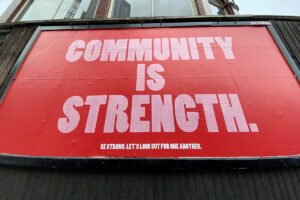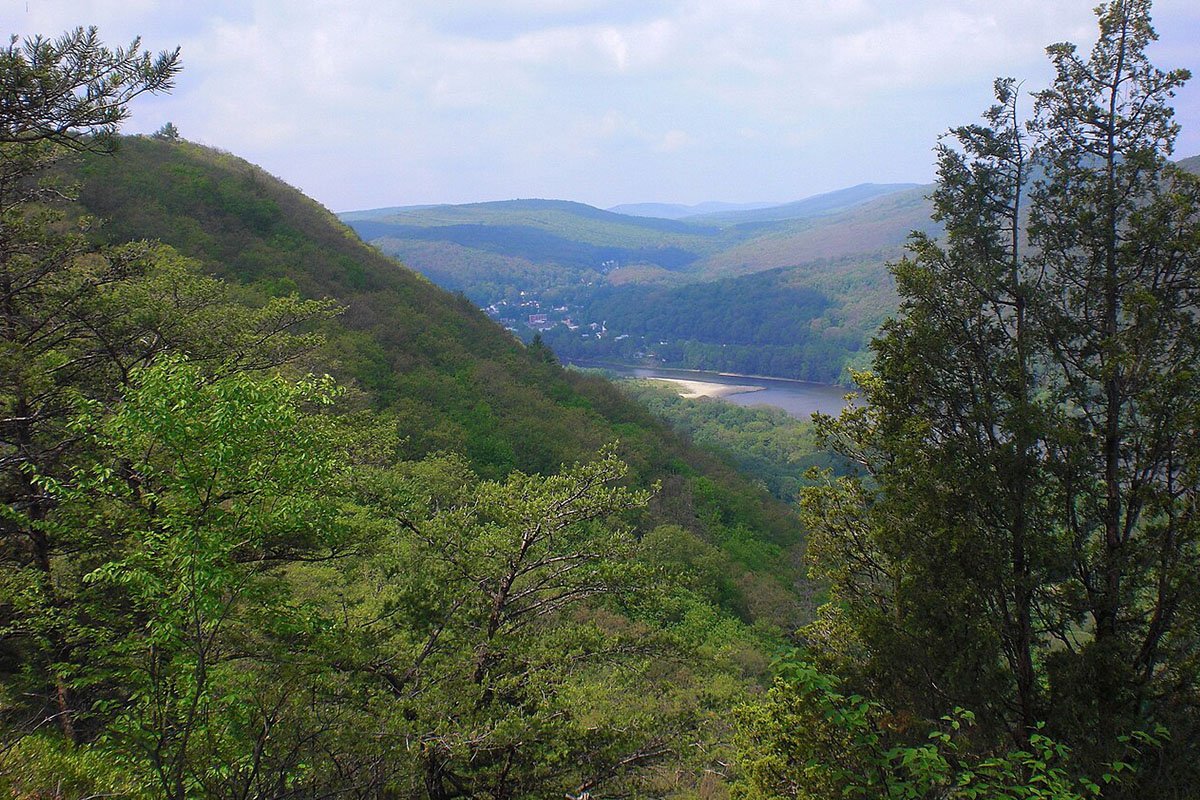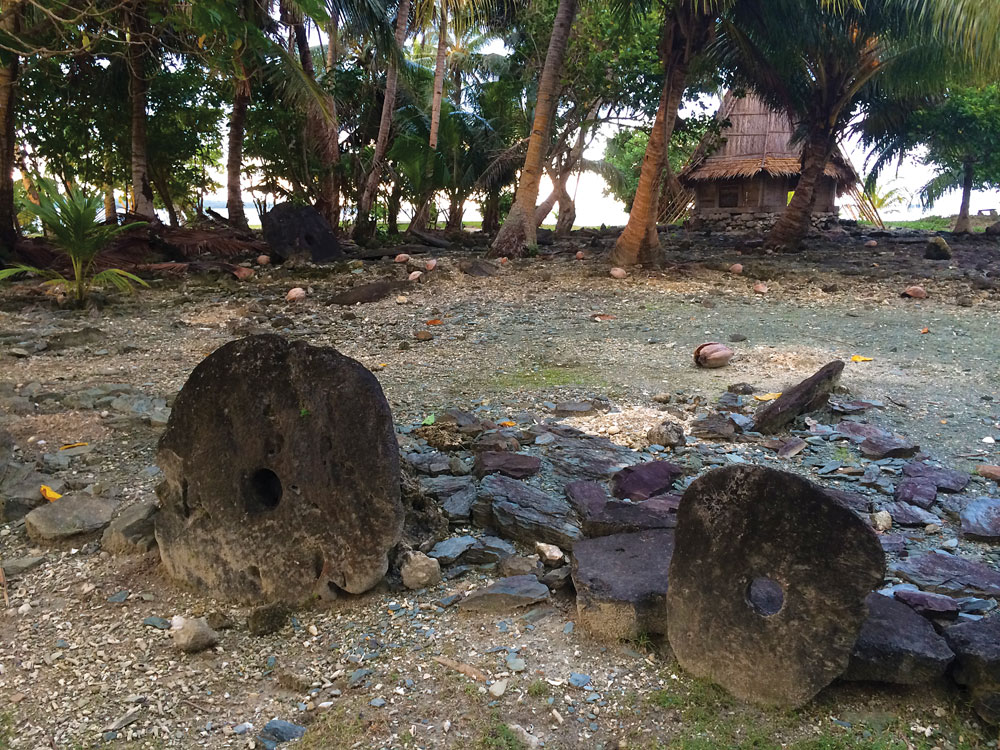
traditional practices. PHOTO: TRISHA KEHAULANI WATSON-SPROAT
This article from the fall 2020 edition of the Nonprofit Quarterly, there published as “Indigenizing Environmental & Climate Justice: Reconciling the Past May Be the Only Way to a Sustainable Future,” is part of a series of works on the subject of environmental justice and Indigenous communities in the United States, curated by Raymond Foxworth of the First Nations Development Institute.
The environmental struggles of Indigenous peoples across the world are unique. Whereas the impacts of large-scale industrial activities pose an increasing threat to the well-being of human populations and ecosystems around the world,1 these threats disproportionately endanger Native peoples, who already, for generations, have been robbed of health, prosperity, cultural access,2 access to natural resources for subsistence purposes, and other well-being indicators. And these impacts are often exacerbated in Indigenous communities by histories of intergenerational trauma,3 including the violent displacement of Native peoples from their ancestral homelands.
Generally, across the planet, there has been an increase in awareness regarding social justice issues, including issues of environmental4 and climate justice.5 These movements have surely reinforced each other—environmentalists’ long-standing concerns about the health of the planet appear to have received a much-needed boost, driven in part by people directly seeing and experiencing the effects of climate change on their local communities.
Most, if not all, environmental justice and climate justice frameworks tend to focus on more recent environmental harms and subsequent environmental degradation. But injustices perpetuated against Indigenous peoples and their lands have a much longer history and are still firmly rooted in worldviews connected to exploitation and domination of land and its resources.
Social movements focusing on environmental and climate justice need to evolve to center histories of Indigenous injustices and the ongoing consequences for Indigenous peoples. Whereas mainstream discussions of environmental racism typically focus on contemporaneous acts of land use and resource exploitation, Indigenous environmental issues are deeply rooted in cyclical acts of displacement and alienation.
This article provides a brief summary of this past and its linkages to communities of people, both in the United States overall and Hawai’i specifically, who have been routinely attacked, pilfered, and excluded from the prosperity and opportunities that should be available to all. Within this history, contemporary acts of environmental racism in Hawai’i are considered and serve as an important lesson when considering how climate issues should be addressed in the Pacific more broadly. Finally, intersectional environmentalism is examined as one potential area in which a more holistic approach to environmental justice and just futures can be considered.
The environmental histories and traumas of Indigenous peoples remain largely absent from the environmental justice discussion, and this must be remedied if we are to develop pathways to a just, sustainable future.
How Historic Injustices Have Robbed Communities of Their Power
Communities that have been violated by historic injustices are more likely to suffer environmental impact than those that have enjoyed historic privileges.6 The US Water Alliance explains: “Vulnerable communities face historic or contemporary barriers to economic and social opportunities and a healthy environment. The principal factors in community vulnerability are income, race or ethnicity, age, language ability, and geographic location. This may include low-income people, certain communities of color, immigrants, seniors, children, people with disabilities, people with limited English-speaking ability, rural communities, Tribal communities, people living in unincorporated areas, people living in public housing, and currently or formerly incarcerated people.”7 This is a good example of a definition and framework that appropriately covers the range of vulnerable communities.
All of these groups would benefit from approaches centering upon the long history of settler violence—acts of latent and manifest aggression directed at peoples by settler-colonial forces—that first were perpetuated against Indigenous peoples. This engenders a discussion that recognizes what is largely spoken of as “vulnerability” but which really ought to be relabeled “threat”—not as a modern phenomenon but rather as a fundamental tenet of Western culture that extends back to the very origins of American society. Understanding that the ways in which inequality and the seizure of land and resources by certain groups at the expense of others are embedded within the foundation upon which the United States was built helps reframe the discussion about the origins of our environmental problems.8
The past is often romanticized. From historians to scientists to climate change activists, too many start the timeline to today’s environmental crisis in the late nineteenth or early twentieth century. This is understandable, given that this is when many groups, particularly people of color (including immigrants), enter the American narrative—but the story actually begins much earlier. It begins when westerners arrived on Indigenous lands and began to interact with Native peoples and their ancestral resources.
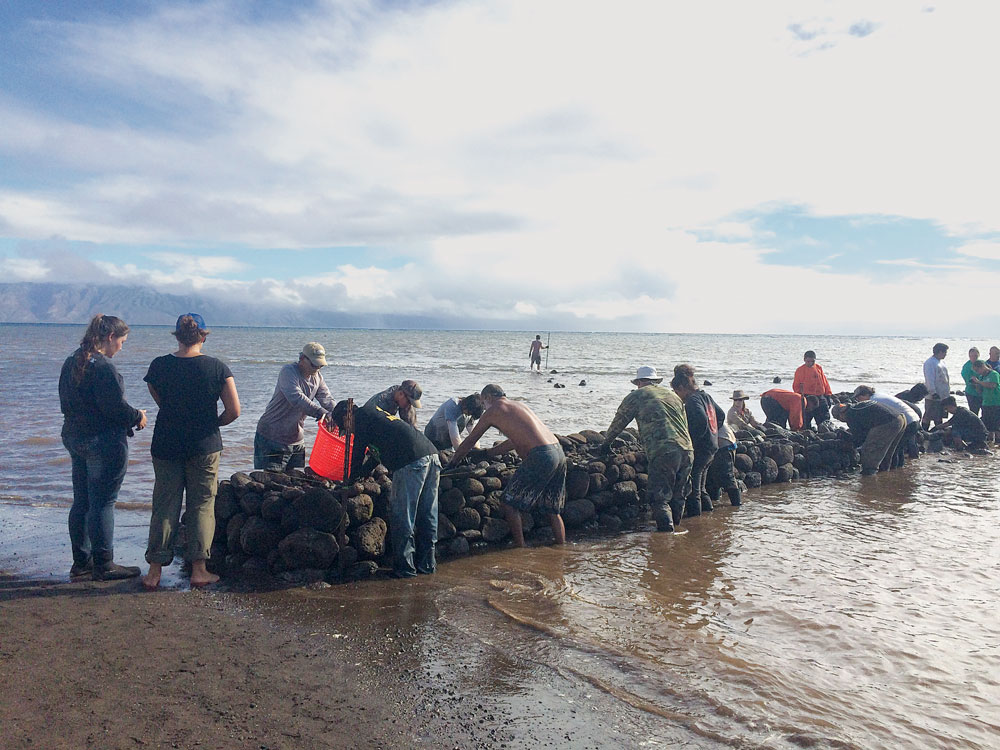
In Hawai’i, this began with the arrival of British explorer James Cook, who happened upon the Hawaiian Islands during a 1778 voyage in the Pacific. Native Hawaiians quickly began to fall ill with diseases introduced by Cook and his sailors. These foreign-introduced diseases included gonorrhea, syphilis, and, likely, tuberculosis. (Cook also introduced alcohol to the islands.9) By the beginning of the 1800s, foreign diseases were having crippling effects on the Indigenous populations. In 1804, approximately 15,000 died from a ma’i ‘ōku’u epidemic (literally, the squatting disease, likely cholera), including high chiefs. The Native Hawaiian population would collapse from an estimated 300,000 at the time of Cook’s arrival10 to a low of 34,000 by 1890.11
Westerners seized upon the opportunity to acquire land holdings and resources, including fresh water, taken from the ailing Native population. Despite efforts to protect land for the Native people, settlers continuously pulled land resources away from Hawaiians. Much of this was to occur through manipulations of policy and litigation12 that continue to dispossess Hawaiians of their family lands to this day.13
By recognizing how inequality, discrimination, and violence were present in American culture from the first arrival of Europeans, we shift from viewing environmental degradation as resulting from industrialization and technology to understanding it as grounded in long-standing American values—and the ways in which those values perpetrate grave harm against people and the environment. Native peoples were the first to be affected, and continue to suffer the effects today.14
Undoubtedly, America’s violent racism, early and present, has devastated other groups—most critically, Black Americans. The purpose of this article is not to attempt to give a full history of America or quantify which groups are the most impacted by its culture, but rather to highlight that it was in Indigenous communities where the intersection of racism and environmental abuses originated, and that the current crisis of environmental injustice extends from long patterns of displacement that allowed settler groups access to ecologically rich lands and resources, while Native peoples were forced onto less fertile lands with scantier resources. Additionally, Western settlers established property boundaries that were based on political agendas rather than environmental sustainability.15 The effects of these political constructs remain today. While the resulting disparities and inequities are felt by multiple classes of people in communities across the country, Indigenous peoples’ experiences are distinct, often overlooked, and worthy of further understanding.
Kinship above All Else
The Western Christian worldview that drove and largely shaped dominant American practices centered on dominion theology,16 which built in part upon the passage from the King James Bible version of Genesis 1:28, in which God gives humans dominion over the earth. The passage reads: “And God blessed them, and God said unto them, ‘Be fruitful, and multiply, and replenish the earth, and subdue it: and have dominion over the fish of the sea, and over the fowl of the air, and over every living thing that moveth upon the earth.’”17
But Indigenous worldviews and connection to lands have always been fundamentally different from those of Western Christianity. First, the relationship Indigenous peoples share with their ancestral lands is one of kinship above all else. Epistemologies were constructed around cosmologies centered on origin stories that linked the genealogies of Native peoples directly to the earth, often through earth or sky progenitors. In Hawaiian tradition, Earth Mother is known as Papahānaumoku, and Sky Father is Wākea.18 Margo Greenwood and Nicole Marie Lindsay explain, “Indigenous values, beliefs, customs and protocols are meant to maintain the relationships that hold creation together.”19 When colonization dismantled these relationships, environmental destruction ensued.
The outcome of the displacement and diaspora resulting from foreign contact is the traumatizing forced removal of these descendants from their earth ancestors. One of the most devastating consequences of this was that the Native Hawaiian peoples, who thrived prior to foreign contact, were left largely unable to steward their ancestral lands.
Stewardship, and in particular the self-sufficiency it accords, presumes the active presence of a population physically capable of completing the daily tasks necessary to manage resources and maintain food sovereignty. The loss of life from foreign diseases meant a significant reduction in the physical labor needed to maintain self-reliance. Family members were burdened with the additional task of caring for others afflicted with illnesses of which Hawaiians had no previous experience, leaving them without traditional knowledge and medicines to turn to for treatment. Resulting infertility left many families without descendants to inherit land and take on stewardship.
Ecocolonization, “the process by which Western forces simultaneously colonize indigenous natural resources and the First People who inhabit that environment,” is a useful lens through which to focus on these early environmental histories. It centers environmental injustice questions around colonization and imperialism—historical patterns that have done their utmost to marginalize and alienate Indigenous peoples and local communities (IPLC) over the course of centuries.20
Ecocolonization has proved to be physically, psychologically, and spiritually devastating for many Native communities, not only Native Hawaiians. For instance, regarding the COVID-19 pandemic, UN News reported that, on the International Day of the World’s Indigenous Peoples, United Nations Secretary-General António Guterres noted, “Throughout history, indigenous peoples have been decimated by diseases brought from elsewhere, to which they had no immunity.”21 The report continues, “While indigenous peoples already faced deep-rooted inequalities, stigmatization and discrimination prior to the current pandemic, inadequate access to healthcare, clean water and sanitation increases their vulnerability, [Guterres] added.”22 It must be recognized first and foremost that many environmental challenges today originate in foreign settlement that saw the environment and natural resources like forest products23 and water24 as commodities.
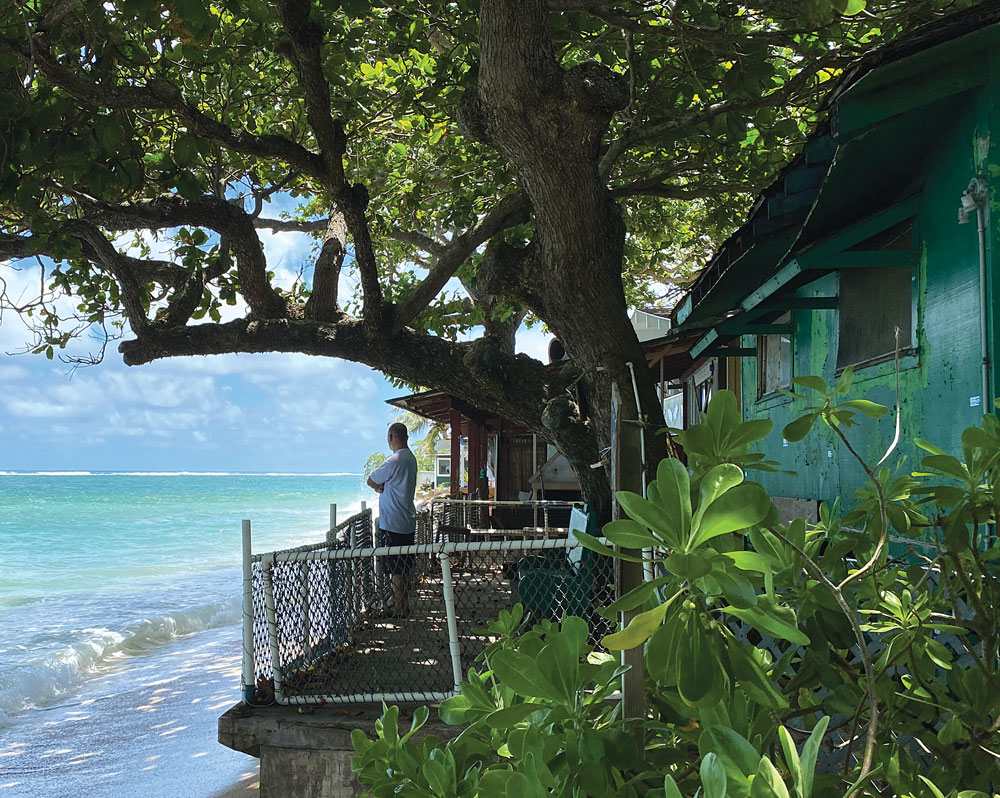
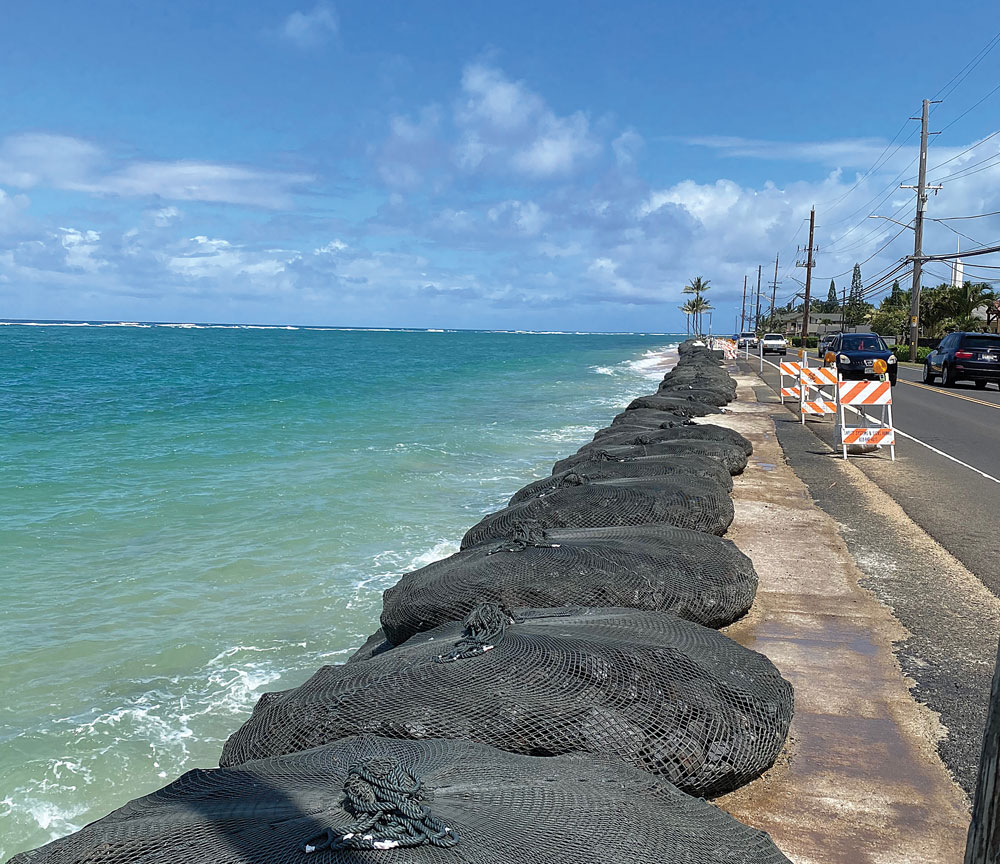
Environmental Racism in Hawai’i
In 1986, the United Church of Christ (UCC) initiated studies “to determine the extent to which African Americans, Hispanic Americans, Asian Americans, Pacific Islanders, Native Americans and others are exposed to hazardous wastes in their communities.”25 The study concluded that “disproportionate numbers of racial and ethnic persons residing in communities with commercial hazardous waste facilities is not a random occurrence, but rather a consistent pattern.”26 Despite the environmental justice movement that grew following the publication of the UCC study, very little, if any, effort to identify patterns of environmental racism occurred in Hawai’i.
My 2002 master’s thesis may be the first study to look at how environmental racism27 applies to Hawai’i’s local communities.28 The study shows how many of the locally unwanted land uses (LULUs) are concentrated in regions with disproportionately high populations of Native Hawaiians. Unlike many Tribal communities, Native Hawaiians do not have reservations. Instead, they have Hawaiian Home Lands—government-controlled and managed lands set aside for Hawaiians with 50 percent or more blood quantum. The federal legislation was passed by the U.S. Congress at the urging of Prince Jonah Kūhiō Kalaniana’ole—heir to the Hawaiian kingdom, who would become the territory’s second U.S. congressman—who felt deep concern over his people’s alienation from their homelands. Selected and set aside by the federal government during the time when Hawai’i was a territory of the United States, these homesteads led to areas with high concentrations of Native Hawaiians. This has been enabled in part by zoning policies that fail to include protective measures for low-income, high-minority or Indigenous communities, and also in part by the comparatively lower political influence held by these communities.29
This study also discusses how O’ahu’s two primary landfills, the municipal Waimānalo Gulch Sanitary Landfill and the PVT construction landfill, were both located in the same district, Wai’anae, heavily populated by Native Hawaiians. In fact, Wai’anae and the larger Leeward Coast of the island of O’ahu are home to one of the largest concentrations of Native Hawaiians in the world.
Two years after the study, in 2005, the Hawaii State Legislature passed Senate Concurrent Resolution 140, which directed Hawai’i’s Environmental Council to “develop and promulgate a guidance document on including principles of environmental justice in all phases of environmental review undertaken pursuant to Chapter 343, Hawaii Revised Statutes.”30 Despite some policy guidance from Hawai’i’s Office of Environmental Quality and Control—which required a nominal consideration of environmental justice issues in environmental review documents—environmental justice regulations were never codified into law. In 2019, when the office updated its regulations, environmental justice considerations were entirely absent.
Nonetheless, an environmental justice movement began to catch fire in Wai’anae, and studies began focusing on the problem of environmental racism in that district.31 In 2009, the environmental organization KAHEA, in collaboration with a number of local organizations, started Huaka’i Kāko’o no Wai’anae—Environmental Justice Bus Tours.32 More people started learning about environmental justice, and specifically the environmental racism that continued to grow on the Wai’anae coast. As one 2012 article explained:
When heavy rains overtopped a reservoir above the municipal landfill and spilled into storm sewers, medical waste washed up on Waianae beaches. The Waianae coast is also home to eleven of eighteen sewage treatment plants, two oil refineries, and the privately owned PVT Nanakuli Construction and Demolition Material Landfill. Residents complain that construction debris includes asbestos dust and other toxic particles blown downwind, contaminating their homes and the nearby elementary school.
From an environmental justice viewpoint, Waianae has a poverty rate double the island average, and is home to Oahu’s largest Native Hawaiian population.33
Whereas the city and county of Honolulu had committed to close the Waimānalo landfill and find a new location, the private owners of PVT Land Company Limited pushed forward with expanding their landfill in Wai’anae, seeking approval to encroach into previously undisturbed lands that house important cultural resources and serve as critical parts of traditional watersheds in the region. For years, PVT has been immediately adjacent to residential communities. Also within the immediate vicinity of the landfill are schools, homes, churches, parks, medical clinics, and community centers.34
Additionally, despite nearly two decades of growing concern about environmental justice issues in the area—about which residents and activists had been vocal—the environmental impact statement for the expansion did not make any reference to or take into any consideration the environmental justice impacts of the project on the communities, particularly the Native Hawaiian community. In response to PVT’s refusal to consider environmental justice issues, community members mobilized to pass legislation at both the county and state levels to stop the expansion. The municipal measure was still pending as of August 2020, but a state measure to create a buffer zone between landfills and residential areas had passed during a January 2020 legislative session. Senate Bill 2386 prohibits any waste or disposal facility from being located in a conservation district, except under emergency circumstances, to mitigate significant risks to public safety and health; it also requires no less than a one-half-mile buffer zone around residences, schools, and hospitals for the construction, modification, or expansion of a waste or disposal facility.35 PVT’s private owners launched a lobbying and public relations campaign to encourage Hawai’i Governor David Ige to veto the bill.36 Happily, despite their efforts, Governor Ige signed the bill into law on September 15, 2020.
Sign up for our free newsletters
Subscribe to NPQ's newsletters to have our top stories delivered directly to your inbox.
By signing up, you agree to our privacy policy and terms of use, and to receive messages from NPQ and our partners.
The example of PVT demonstrates how strongly political environmental racism is in Hawai’i. Even when communities are able to mobilize to be politically influential, private interests work hard to retain power in a manner that best serves their financial interests, even above the welfare of natural or cultural resources. This is a critical lesson to apply to discussions of climate change. As widespread impacts from climate change increase, governments will need to develop equitable ways of implementing climate adaptation, so that the environmental injustice that plagues so many communities does not become further exacerbated.
Climate Injustice on the Horizon
My husband grew up in a small town called Hau’ula, on the North Shore of the island of O’ahu. His childhood home is a small community, where just about everybody knows one another. The majority of the homes are modest dwellings built over a century ago that have been in families for generations and remain largely unchanged. Many of the families also rely on the ocean for subsistence and traditional practices.
Lacking access to the capital and/or other resources to protect their properties, many multigenerational family homes, like those near my husband’s family home in Hau’ula, are directly feeling the threat of climate change and the potential loss of family lands. A 2019 Civil Beat article about the problem of inequity in the climate response explains:
Wealthy foreign investors and U.S. mainland speculators have snatched up many of the oceanfront properties in Hawaii, turning them into second homes or vacation rentals for the hordes of tourists who come to experience the islands each year.
But there are also many homes still owned by longtime middle-class residents who bought them before prices skyrocketed or inherited properties from relatives at a time when global warming was discussed more in scientific journals than on international stages as the biggest crisis of our time.37
Multigenerational families and working-class families—many of whom are Hawaiian or the descendants of immigrant laborers brought to Hawai’i to work on island plantations, and who inherited their shoreline property from family—increasingly are finding themselves faced with the challenge of protecting their homes as sea levels rise. These families largely rely on natural or low-impact ways—like the maintenance of large trees and other vegetation along shorelines—to protect their properties and livelihoods. This is a stark contrast to new, wealthy, predominantly white residents in the region, who have taken expensive, extreme, and unpermitted measures to build large seawalls to protect recently purchased properties—measures that have significant impacts on beaches and coastal areas. Seawalls are by and large illegal in Hawai’i. Recognizing the serious adverse impacts these structures have on coastal areas, the state has taken measures to significantly limit homeowners’ ability to fortify their properties, generally limiting that privilege to seawalls that have been in existence for generations and are grandfathered into state law. Yet this has not stopped wealthy landowners from taking steps, even illegal ones, to protect their expensive homes.
Just down the road from Hau’ula, no more than fifteen miles away, is the area most people have in mind when they picture the North Shore, increasingly defined by large palatial estates. Once inhabited by traditional Hawaiians, the area is now dominated by first-generation residents, many attracted to the area’s surfing community. Hawaiian and local residents are often harassed and chased away from beaches by these newcomers. A comparison of these two different towns and two different communities tells us much about the looming climate injustice and its potential impact on Indigenous peoples.
Over the past few years, local news outlets have reported stories of wealthy North Shore landowners taking steps to build large seawalls and otherwise fortify the shoreline between their homes and the sea. One well-publicized example is the case of James and Denise O’Shea, who purchased a beachfront property on O’ahu’s iconic Sunset Beach. The O’Sheas bought the property in 2001 for a comparatively reasonable price of $575,000. Within five years, they would make $38,500 worth of improvements to the home, resulting in an increase in the total property assessed value from $596,300 in 2001, when they purchased the home, to $2,043,100 in 2007, after the improvements were completed.38
In 2001, when the O’Sheas made their investment, the threat of sea level rise,39 across the world40 and particularly in Hawai’i,41 was already known fact.42 The O’Shea property was one of only a few properties with “shoreline armoring along this stretch of Sunset Beach,” as the seawall was already present on the property.43 Additionally, the home is located on “ceded” lands, lands that were designated for Hawaiian chiefs and the Kingdom of Hawai’i during the mid-nineteenth century, then seized and ceded by the American government.
An official state investigation would later find: “The beach [fronting the property] is exposed to swells from the north Pacific in the winter months and easterly tradewind waves year-round. The beach is composed of carbonate coarse sand and characterized by occasional outcrops of limestone that are intermittently buried or exposed by shifting sand. Long-term shoreline change rates in the vicinity of the subject property have trended towards chronic recession (approximately 0.5 to 0.6 feet per year).”44 This meant that the beach in front of the property was already experiencing “chronic” shoreline loss when the O’Sheas purchased the property, in 2001. Warranty deeds issued for the property in 2010 and 2012 even recorded encroachments on the property that either ran within the existing beach access or the Pacific Ocean.45
Increased storm events continued and became more impactful in the mid-2010s. Unlike places that experience four distinct seasons, Hawai’i, like many tropical environments, experiences primarily two seasons: a wet (winter) season and a dry (summer) season. With Hawai’i’s wet season comes high, often dangerous, surf, particularly on the North Shore. And in September 2017, the seawall on the O’Sheas’ property collapsed.46
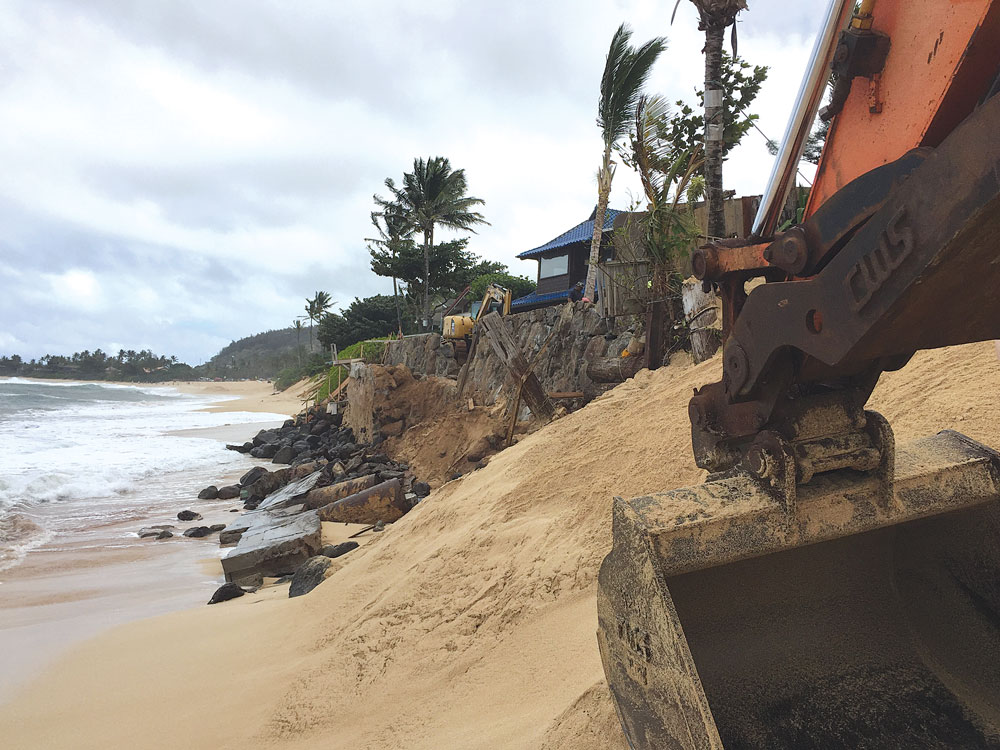
Beaches are critical natural resources that support endangered species, recreation, and cultural practices—and they are disappearing at an alarming rate in Hawai’i, due to hardening of the shoreline. Seawalls and other forms of shoreline armoring can be highly detrimental to a beach’s ecosystem. A hardened shoreline can result in beach loss and beach narrowing by accelerating sand loss in front of and adjacent to it.
After the O’Sheas’ seawall collapsed, they immediately began to reconstruct it without authorization. Despite the significant impact constructing a new wall would have on this pristine North Shore beach, they proceeded unabated. The O’Sheas were reported to the appropriate state enforcement agencies, and an investigation was launched.
The state of Hawai’i served a violation notice and temporary restraining order on the O’Sheas, but work continued on the wall. The state administrator in the case would later testify: “We have essentially a seawall that was completely rebuilt, and it was done without any sort of permit from any government entity, any approval, any consent, on one of the most spectacular beaches in [sic] the planet.”47 Neighboring properties have now also begun work on towering, unpermitted seawalls, despite the known detriments to the beach and coastal environment.
As climate change intensifies and climate vulnerability increases throughout the Hawaiian and Pacific Islands, situations like these will only worsen. Without policies that significantly consider injustice and plan for just action, inequities across different social and cultural groups will only increase. Climate crisis does not impact all groups equally. Ethnic minorities, Native populations, and working classes, for instance—groups that have been robbed of wealth and access to resources—are at greater risk of being impacted by the growing climate crisis, and the first to suffer the effects.
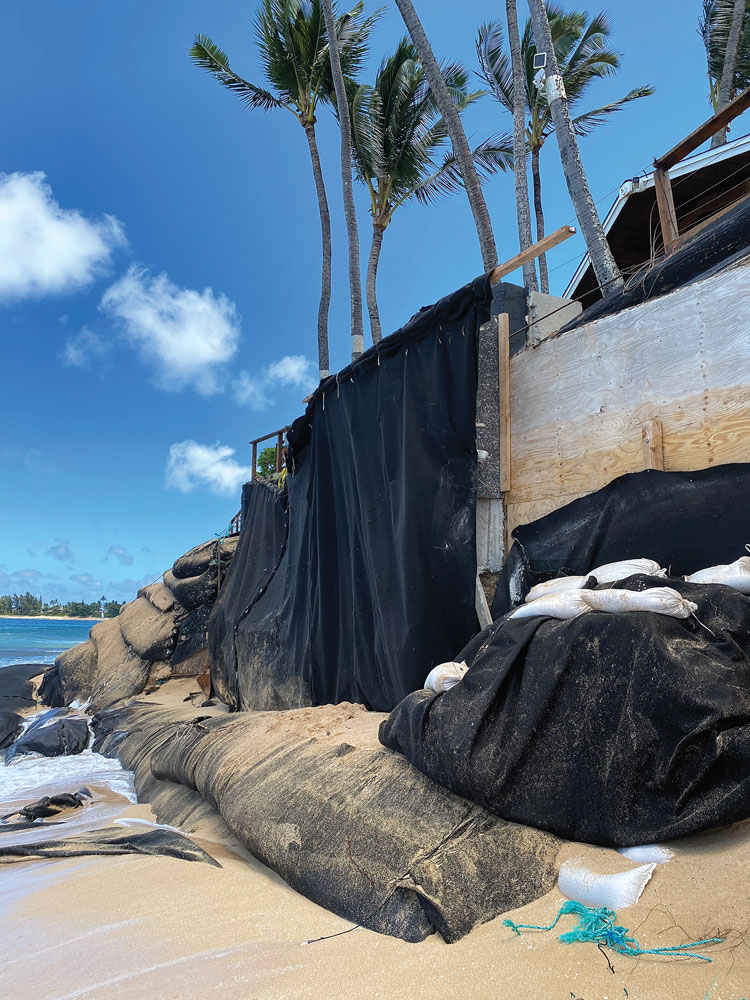
It is inevitable that communities, particularly island communities, will need to implement climate adaptation and shoreline retreat strategies soon. And it is increasingly critical that a social justice lens be applied to these policies and strategies. Failure to recognize how certain communities disproportionately bear the brunt of climate impacts will have calamitous results.
The Pacific has already begun to see large-scale devastation from climate change. Sea level rise and increased severe storm events have ravaged many Pacific islands. These tragedies have taught much about the multitude of ways in which climate injustice impacts Indigenous peoples and local communities.
Pacific Island communities are already underrepresented in important environmental dialogues.48 This is particularly problematic, since, as a recent Marine Policy article explains, “their lives, food, and livelihoods depend on the health of ocean resources.” The article continues, “Indigenous Peoples have, through millennia, developed social-ecological systems of marine resources management that rely on cultural traditions as well as an intimate, dynamic and long-term knowledge of the environment.”49
Pacific Island communities are particularly vulnerable, from the Bikinians—who were forcibly displaced from their homeland beginning in the 1940s, so that the United States military could conduct nuclear testing on their island—to the I-Kiribati, whose home of Kiribati has suffered catastrophic devastation from sea level rise and climate change. The Indigenous peoples and local communities of the Pacific have suffered magnitudes of historic trauma and violence as a result of ecocolonization.50 While vulnerability to climate is exacerbated in the Pacific due to the nature of its low-lying islands, understanding the political dynamics of how different communities are empowered—or not—to respond to the effects of climate change provide important warning signs of looming patterns of institutionalized injustice.
Climate change threatens to wipe out entire island nations. Indigenous peoples and local communities throughout the Pacific face daily threat from cyclones, tsunamis, king tides, and washover events, all of which imperil cultural resources such as the Rai (stone money) of Yap (see photo on pp. 16–17), Indigenous pedagogies, traditional and customary practices, and ancestral communities. Pacific communities have demonstrated remarkable fortitude over the centuries, but the complete loss of nations and homelands is a catastrophe for which many peoples and countries remain unprepared.
Traditional Ecological Knowledge and Just Solutions: Intersectional Environmentalism as a Potential Path to Justice and Sustainability
Hawai’i serves as an important example in analyzing how institutional racism and environmental issues intersect to put certain communities at greater risk of impact resulting from climate change. Hawai’i’s history of environmental racism provides critical information in creating a new paradigm by which to assess and bolster these communities. Understanding the ways in which institutionalized racism has impacted land use and natural resources can lead to the creation of new matrices that can inform policies on climate.
Scholars are beginning to explore linkages between environmental inequality and environmental vulnerability, despite their having developed as distinct dialogues.51 There is still so much work to be done to fully explore this intersectionality, particularly as it relates to environmental racism and Indigenous communities.52
This is where philanthropy can play an important role in supporting indigenizing environmental and climate justice—and through that work, identifying critical solutions from larger environmental problems toward supporting Indigenous groups in increasing their community, cultural, and ecological strengths. This is a particularly important endeavor, right now, as COVID-19 is disproportionately impacting Indigenous peoples.53
Another important effort is support for intersectional work. Some of this work is already under way, as in recent years movements have intersected with issues of race, gender, class, and, to a lesser degree, indigeneity. Intersectional environmentalism has steadily gained traction,54 finding footing not only in communities but also in some government agencies across the country that are looking to identify more equitable processes and outcomes.55
Bringing diverse groups together is powerful work. These communities can learn from each other and build coalitions and partnerships that address environmental challenges in a holistic and just way. All of society benefits from such efforts.
The solutions for the future demand that we look back into the past. It must be a long, hard look, and it will surely be uncomfortable for many people, especially those belonging to groups that have enjoyed privilege at the expense of others. That gaze into the mirror can be a hard one to reconcile. It doesn’t need to be.
There’s perhaps a mistaken impression that Indigenous peoples call for this hard look at history because there is a desire to assign blame. This isn’t true. Indigenous advocacy for embracing the past is much more about healing than hurt. The perpetuation of traditional ecological knowledge has been shown to be an important element for healing Native communities and improving their well-being.56
These intersectional efforts are about more than justice; they are also about understanding the ways in which traditional ecological knowledge can provide important solutions for addressing the effects of climate change. Hawaiians, like many Pacific Islanders and Indigenous peoples, possess intimate knowledge of their surrounding environment. This knowledge, acquired over multiple generations, was built upon a scientific mythology that employed observation to develop best practices in maintaining sustainable communities. This deep kinship with nature provided Indigenous peoples with the ability not only to thrive in their environments but also to adapt to changing environmental conditions.
Indigenous peoples are situated to be powerful actors in the future of environmental and climate solutions. As knowledge keepers, they can be problem solvers within their homelands and around the world. Once upon a time, the Indigenous peoples of this world not only lived among nature but thrived alongside it. It is a glorious past, and one that can help us to navigate a collective path toward a powerful, just, sustainable future.
Notes
- Paul Shrivastava, “Industrial/environmental crises and corporate social responsibility,” Journal of Socio-Economics 24, no. 1 (Spring 1995): 211–27.
- “Cultural access” is a legal right for Hawaiians and other Indigenous peoples.
- Karen Menzies, “Understanding the Australian Aboriginal experience of collective, historical and intergenerational trauma,” International Social Work 62, no. 6 (November 2019): 1522–34.
- David L. Gadenne, Jessica Kennedy, and Catherine McKeiver, “An Empirical Study of Environmental Awareness and Practices in SMEs,” Journal of Business Ethics 84, no. 1 (January 2009): 45–63.
- Andrew Revkin, “Most Americans now worry about climate change—and want to fix it,” National Geographic, January 23, 2019.
- Susan L. Cutter, Hazards, Vulnerability and Environmental Justice (London: Earthscan, 2006); and Greg Bankoff, Georg Frerks, and Dorothea Hilhorst, eds., Mapping Vulnerability: Disasters, Development & People (London: Earthscan, 2004).
- US Water Alliance, An Equitable Water Future: A National Briefing Paper (Washington, DC: US Water Alliance, 2017).
- Carl A. Zimring, Clean and White: A History of Environmental Racism in the United States (New York: NYU Press, 2016).
- Kekuni Blaisdell, “Hawaiian Health Timeline and Events,” 1998, updated in 2016 by Papa Ola Lokahi.
- “Estimated Population of the Hawaiian Islands: 1778–1896,” Trends: Demography, Office of Hawaiian Affairs, accessed August 18, 2020.
- Blaisdell, “Hawaiian Health Timeline and Events.”
- Sally Engle Merry, Colonizing Hawai’i: The Cultural Power of Law (Princeton, NJ: Princeton University Press, 2000).
- Noelani Goodyear-Ka’ōpua, Ikaika Hussey, and Erin Kahunawaika’ala Wright, eds., A Nation Rising: Hawaiian Movements for Life, Land, and Sovereignty (Durham, NC: Duke University Press, 2014).
- Carrie Bourassa et al., “Understanding the Intergenerational Effects of Colonization: Aboriginal Women with Neurological Conditions—Their Reality and Resilience,” International Journal of Indigenous Health 10, no. 2 (December 2015): 3–20.
- Epeli Hau’ofa, We Are the Ocean: Selected Works (Honolulu, HI: University of Hawai’i Press, 2008).
- Lynn White Jr., “The Historical Roots of Our Ecologic Crisis,” Science 155, no. 3767 (March 10, 1967): 1203–07.
- Gen. 1:28 (AV).
- For examples of creation stories from other Native American peoples, see “Native American Creation Myths and Legends: Native American Creation Stories,” accessed August 18, 2020.
- Margo Greenwood and Nicole Marie Lindsay, “A commentary on land, health, and Indigenous knowledge(s),” Global Health Promotion 26, no. S3 (April 2019): 82–86.
- My doctoral dissertation focused on this. See Trisha Kehaulani Watson, “Ho’i Hou iā Papahānaumoku: A History of Ecocolonization in the Pu’uhonua of Wai’anae” (PhD diss., University of Hawai’i at Mānoa, 2008).
- “On International Day, UN chief spotlights indigenous peoples’ resilience in face of COVID-19 pandemic,” News, United Nations, August 10, 2020.
- Ibid.
- Jennifer L. Anderson, “Nature’s Currency: The Atlantic Mahogany Trade and the Commodification of Nature in the Eighteenth Century,” Early American Studies: An Interdisciplinary Journal 2, no. 1 (Spring 2004): 47–80.
- Jacque (Jody) Emel, “RESOURCE INSTRUMENTALISM, PRIVATIZATION, AND COMMODIFICATION,” Urban Geography 11, no. 6 (1990): 527–47.
- Commission for Racial Justice, Toxic Wastes and Race in the United States: A National Report on the Racial and Socio-Economic Characteristics of Communities with Hazardous Waste Sites (New York: United Church of Christ, 1987).
- Ibid.
- Chad Montrie, The Myth of Silent Spring: Rethinking the Origins of American Environmentalism (Oakland: University of California Press, 2018), 136.
- Trisha Kehaulani Watson, “The Changing Face of Environmental Racism: Why the Current Legal Model of Environmental Justice Fails” (master’s thesis, Washington State University, 2002).
- Reverend Benjamin Chavis, United Church of Christ executive director and chief executive officer of the Commission for Racial Justice, defines environmental racism as “racial discrimination in environmental policy-making and the enforcement of regulations and law, the deliberate targeting of people of color communities for toxic waste facilities, the official sanctioning of a life-threatening presence of poisons and pollutants in people-of-color communities.” He continues, “It is also manifested in the history of excluding people of color from leadership in the environmental movement.” See Stacy M. Brown, “Environmental Racism Killing People of Color,” Greenlining, January 17, 2019.
- Leslie R. Kahihikolo, Hawai’i Environmental Justice Initiative Report (Honolulu, HI: State of Hawai’i Environmental Council, 2008).
- Chasid M. Sapolu, “Dumping on the Wai’anae Coast: Achieving Environmental Justice through the Hawai’i State Constitution,” Asian-Pacific Law & Policy Journal 11, no. 1 (January 1, 2009): 204–45.
- “EJ Bus Tours,” KAHEA, The Hawaiian-Environmental Alliance, accessed August 19, 2020.
- Rachel Harvey and Annette Koh, “Landfill in Paradise: Politics of Waste Management and Environmental Justice in Hawaii,” Anthropology News 53, no. 8 (October 2012).
- Anthony Makana Paris and Kamuela Werner, “Not in Anyone’s Backyard,” Ka Wai Ola, April 30, 2020.
- A Bill for an Act, Relating to Waste Management, S.B. 2386, S.D. 2, H.D. 2, 30th Leg., Reg. Sess. (2020), State Of Hawai’i.
- Andrew Gomes, “State Legislature sides with Nanakuli landfill opponents,” Star Advertiser, July 29, 2020.
- Nathan Eagle, “Losing a Beachfront Home Isn’t Just A Rich Person’s Problem,” Honolulu Civil Beat, accessed August 19, 2020.
- City and County of Honolulu Department of Budget and Fiscal Services, Real Property Assessment Division, report page, accessed September 5, 2020; and see City and County of Honolulu, Department of Budget and Fiscal Services, Real Property Assessment Division. Parcel Information for Parcel Number 590020250000, accessed August 10, 2020.
- T. Houghton et al., eds., Climate Change 2001: The Scientific Basis (Cambridge, UK: Cambridge University Press, 2001).
- Lesley Hughes, “Biological consequences of global warming: is the signal already apparent?,” Trends in Ecology & Evolution 15, no. 2 (February 2000): 56–61.
- Eric E. Grossman and Charles H. Fletcher, III, “Sea level higher than present 3500 years ago on the northern main Hawaiian Islands,” Geology 26, no. 4 (April 1998): 363–66.
- Clifford J. Hearn and Marlin J. Atkinson, “Effects of Sea-Level Rise on the Hydrodynamics of a Coral Reef Lagoon: Kaneohe Bay, Hawaii,” in Sea-Level Changes and Their Effects, ed. John Noye and Marcus Grzechnik (London:World Scientific Publishing Co., 2001), 25–47.
- State of Hawaii. Department of Land and Natural Resources. Honolulu, Hawai’i. Office of Conservation and Coastal Lands. Regarding: Conservation District Enforcement File OA-18-06. Alleged Unauthorized Land Uses in the Conservation District. October 13, 2017.
- Ibid.
- State of Hawaii Bureau of Conveyances. Document Number 2010-196575. Warranty Deed for Tax May Key No. (1) 5-9-002-25. Recorded December 17, 2010; and State of Hawaii Bureau of Conveyances. Document Number A-47371165. Warranty Deed for Tax May Key No. (1) 5-9-002-25. Recorded December 20, 2012.
- State of Hawaii. Department of Land and Natural Resources. Office of Conservation and Coastal Lands. Regarding: Conservation District Enforcement File OA-18-06. Alleged Unauthorized Land Uses in the Conservation District. October 13, 2017.
- Chelsea Davis, “Family faces $75K in fines for defying DLNR in effort to save home,” Hawaii News Now, October 13, 2017.
- Marjo K. Vierros et al., “Considering Indigenous Peoples and local communities in governance of the global ocean commons,” Marine Policy 119 (September 2020).
- Ibid., 2.
- Paul Alan Cox and Thomas Elmqvist, “Ecocolonialism and indigenous knowledge systems: village controlled rainforest preserves in Samoa,” Pacific Conservation Biology 1, no. 1 (1994): 6–13.
- Stacia S. Ryder, “A Bridge to Challenging Environmental Inequality: Intersectionality, Environmental Justice, and Disaster Vulnerability,” Social Thought and Research 34 (2017): 85–115.
- Ingrid R. G. Waldron, There’s Something in the Water: Environmental Racism in Indigenous and Black Communities (Black Point, Nova Scotia: Fernwood Publishing, 2018).
- Jevay Grooms, Alberto Ortega, and Joaquin Alfredo-Angel Rubalcaba, “The COVID-19 public health and economic crises leave vulnerable populations exposed,” Up Front (blog), Brookings Institution, August 13, 2020.
- “Dismantle Systems of Oppression in the Environmental Movement,” Intersectional Environmentalist, accessed August 26, 2020.
- United States Environmental Protection Agency, “EPA’s Role in Promoting International Human Rights, Rights of Indigenous Peoples, and Environmental Justice,” last modified January 2020; and U.S. Green Building Council, “USGBC Equity Summit,” accessed August 19, 2020.
- Symma Finn, Mose Herne, and Dorothy Castille, “The Value of Traditional Ecological Knowledge for the Environmental Health Sciences and Biomedical Research,” Environmental Health Perspectives 125, no. 8 (August, 2017).



